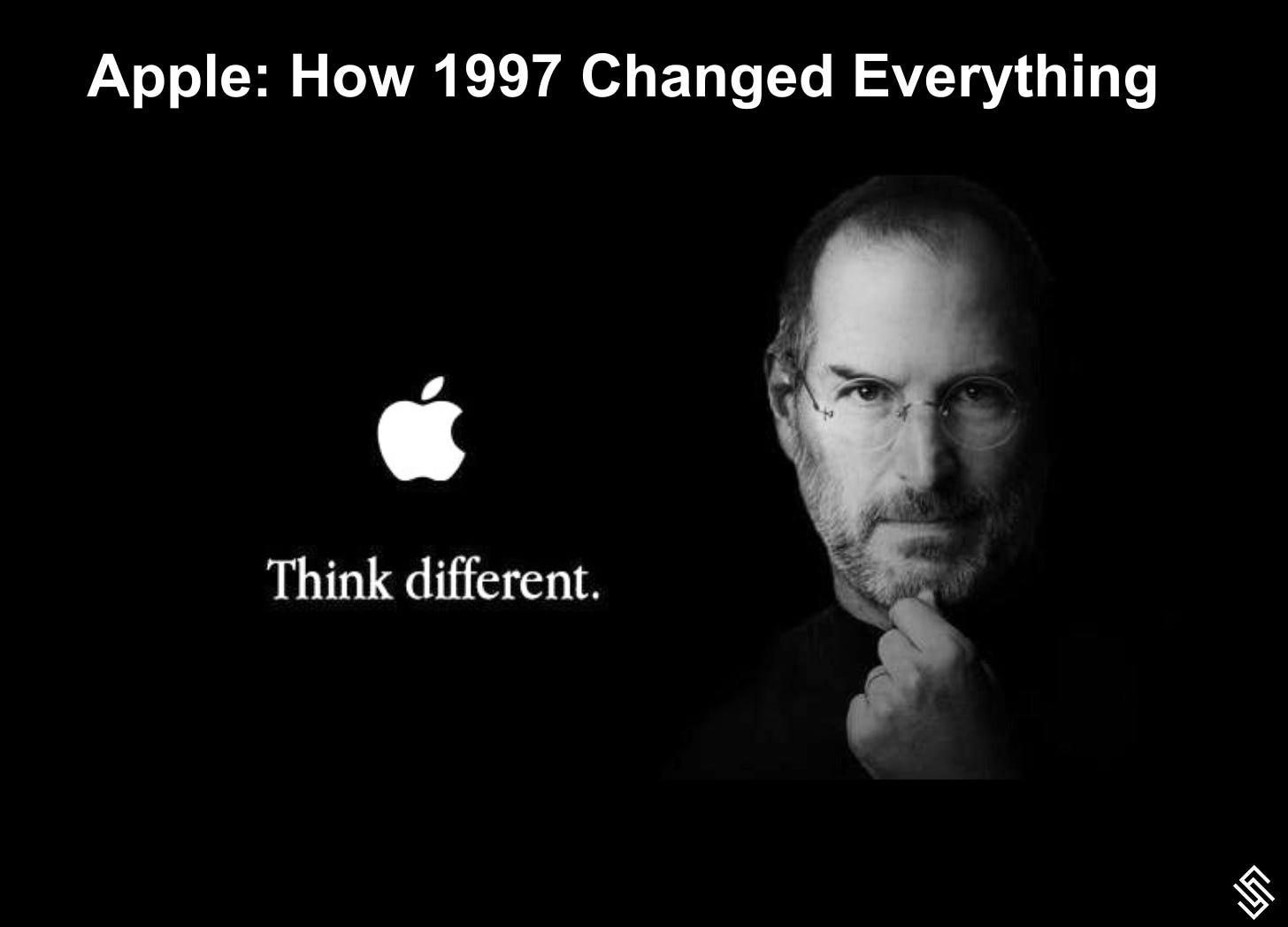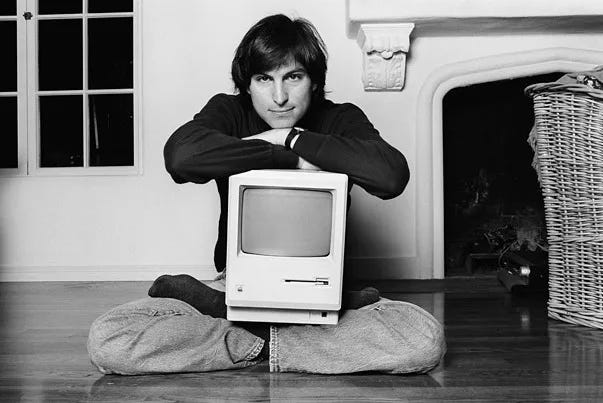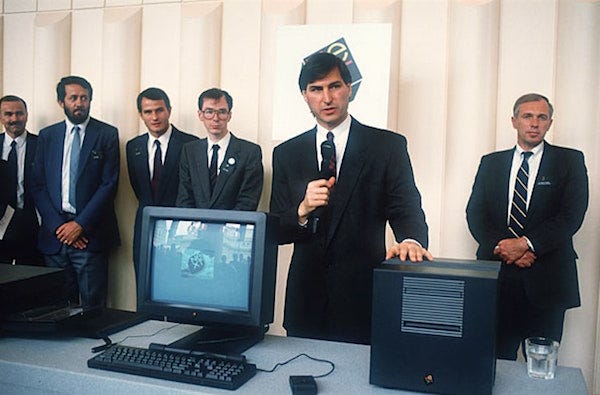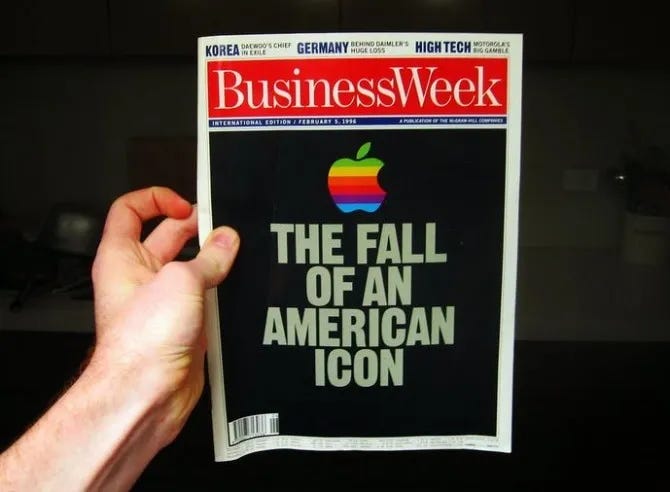Apple has got this breathtaking story from 1997 when the company was almost on the road to bankruptcy. The founder and then-CEO of Dell, Michael Dell even said, "If I were running Apple, I would shut it down and give the money back to the shareholders."
All in all, Apple was so done. But 1997 was the year that changed everything for the company. This begs the question: Why was 1997 so special, and what really happened that year? Well, it’s a pretty interesting story that I want to cover in three main parts.
In the first part, I’ll give you an overview of what really happened before 1997. Then in the second part, I’ll show you what exactly happened in 1997 and why it was a special year for Apple. And in the third part, I’ll walk you through how this one single event saved Apple from bankruptcy and made it the trillion-dollar company it is today.
Very fascinating story, let’s dive in!
The Unexpected
The real story begins in 1985 when Apple decided to fire Steve Jobs from his chairman role on the board of the company, Apple. The reason? You know that famous line Steve Jobs said to a guy: "Do you want to sell sugar water for the rest of your life, or do you want to come with me and change the world?"
The guy was none other than John Sculley, who became the CEO of Apple in 1983 after leaving PepsiCo, where he was the president of Pepsi-Cola (the soft division of PepsiCo). But within the two years of working together at Apple, things between Jobs and John started to shatter.
On one side, Jobs was visionary, emotionally intense, demanding, micromanager, and was the soul of the company when it came to innovation and building products. On the other hand, John was a seasoned executive who was a master at running a global brand. But things weren’t going as expected, Jobs wanted to take risks, bet on innovation, while John wanted profit and stability.
The tension between the two escalated when Apple started working on a new Macintosh project, which Jobs was leading. The first original Mac launched in 1984, but it didn’t go as expected, putting pressure on Jobs.
As already discussed, Jobs was an obsessive, micromanager, and demanding, often clashing with the team and employees. Seeing this, the board members of Apple got worried not just for the product's financial performance but also for Jobs' chaotic leadership style.
Now here things get interesting…
For John, Jobs was the fork in the road for the company. Coincidentally for Jobs, John was a fork in the road, and he wanted to remove him from his position. This was the same guy Jobs himself once recruited and admired his work, but was no longer satisfied with his leadership style at Apple.
By mid-1985, the tension between Jobs and John had reached a boiling point. Around the same year, John Sculley was preparing to leave on a business trip to China. Jobs saw this as an opportunity and held a meeting with senior executives, explaining his master plan. Basically, Jobs wanted to convince executives and teams so he could become the new CEO of the company.
But guess what? Things didn’t go as planned. Someone informed John about what Jobs was doing behind his back to remove him from his CEO role. This was pretty shocking to him, so he canceled his trip, directly talked to Jobs about it, and held a meeting with the board of directors immediately.
Now this was the time when Apple had to choose between Jobs and John. They did John.
After this accident, Jobs was still the chairman of the board, but he was stripped away from all executive powers and removed from day-to-day product leadership, essentially kicked to the sidelines. Seeing no importance, A few months later in September 1985, Jobs resigned from Apple to start his new company, NeXT.
Guess what happened to Apple after all this?
Apple losing Jobs was one of the worst things happened to the company. Although Jobs did make a mistake here but guess what, he was a visionary, great founder, and thinker, and losing that kind of person was a big deal for the company.
And this was the only reason Apple, from 1985, started to go downhill.
Around 1985, Apple's domination in the PC market was around 10-12% (mostly dominated by Microsoft and IBM!), but as the year went by, it only went down, reaching its lowest of 3-5% by 1996. Macintosh was not a failure, but since the idea behind the builder of the product wasn’t around, the product struggled to sell, leading to obscurity.
Another biggest failures Apple saw in the absence of Jobs was its new product, Apple Newton, which was released in 1993. It was a groundbreaking product in concept, but wasn’t refined enough, resulting in its failure in the market. And lastly, the leadership at Apple only got worse as the year went by. Apple went through three different CEOs in the absence of Steve Jobs, but couldn’t figure things out for the company.
On the other hand, Steve Jobs was cooking at his new company, NeXT.
The Return
Jobs resigned from Apple in September 1985, wasting no time, he started his new company NeXT in October 1985. He initially invested his own $7 million to kick off the project and start building a revolutionary computer platform for higher education and scientific research.
After building its new product for a few years, the company, NeXT released its first, gorgeous, industrial, ahead of its time, new computer in 1988, which had a black magnesium cube design, came with an optical disk, a high resolution display, and ran on NEXTSTEP—a Unix-based operating system with a graphical user interface.
Everything was good except one thing: the computer they built was expensive, starting from $6,500 to $10,000. However, the company did manage to sell 50,000 units during its entire hardware lifespan.
But then around 1993, Jobs decided to stop manufacturing hardware and started focusing only on the software part of the company, particularly NEXTSTEP, which was highly respected in academic and enterprise circles for its stability and elegance.
Overall, NeXT became a successful company.
But on the other hand, Apple was struggling: its aging Mac OS was outdated, which was originally released in 1984 with the Macintosh. It lacked true multitasking, protected memory, modern networking, and stability, resulting in being outcompeted by Microsoft and IBM.
Who once revolutionized the personal computer industry was on the road to bankruptcy. Why? All because it lacked innovation, and mostly because the company was not building something new, something that people would love to use. On top of that, the existing products and programs of Apple sucked, for example its Mac OS.
The company’s situation was so bad that by the fall of 1996:
Had 3,800 layoffs
Posted over $1 billion in losses
Only 90 days to go bankrupt
Apple was a lost ship.
So guess what? Somehow Apple knew that if they wanted to save the company, they first needed to have a better, innovative operating system. When they thought it through enough, they came to the realization that they had one of the two companies to acquire:
BeOS
NeXTSTEP
Firstly, Apple tried to negotiate a deal with BeOS, but they realized that the founder of BeOS, Jean-Louis Gassée, a former Apple executive, was asking for $300 to $400 million, which Apple thought was overpriced. So they reached out to Steve Jobs, asking to acquire NeXTSTEP. And it turned out that Apple's buying NeXTSTEP was a better deal for the company, as NeXTSTEP had a working, proven development environment and strong long-term potential.
The board of directors at Apple agreed to close the deal, finalized by then-CEO of Apple, Gil Amelio, for $429 million in December 1996, potentially bringing Jobs back to Apple. Soon Jobs was back at his founding company, Apple, but the board of directors and executives had just given him a role as an “Informal Advisor” in the company.
But Jobs had something else on his mind.
Jobs had already decided to take control of the company and to become the new CEO. To do this, he first started inserting NeXT employees at Apple who deeply trusted Jobs. He also began understanding the chaotic leadership of then-CEO Gil Amelio and let it collapse.
Jobs also gave little to no credit to Gil for Apple acquiring NeXT and often refused to defer in meetings, quietly building support from board members and teams. He slowly began advising on product strategy, marketing, and software direction.
By mid-1997, Jobs outmaneuvered Gil, ousting Gil as CEO of the company, citing Apple’s financial losses. But Jobs, instead of becoming the CEO of the company immediately, became “Interim CEO,” allowing him to take control of the company.
Now the path was clear, Jobs was “Literally” the CEO of the company, and could do anything he wanted to do to take the company forward. However, Apple was in turmoil, and it had to overcome this disastrous moment.
There are a couple of things Jobs had to do to save Apple:
Turn losses into profits
Rebuild the Apple brand
Build a clear product strategy
As he did.
First, to save the company, and second, to reimagine Apple, Jobs had to make some smart moves and decisions, otherwise, he would have been blamed for the death of Apple.
Here’s what he did:
#1: Product Line: Before Jobs' arrival, Apple’s product line was a total mess. The company was building around 70 different products/variations. Jobs said, “This is crazy” and cut back projects from 70 to just 4, allowing the company to only build products that mattered.
#2: Fixed distribution system: When Jobs returned to Apple, he learned that the Apple distribution system was a total disaster, designed for a poor customer experience. Jobs hated it and refined the distribution system, making it simpler and better.
#3: Fixed Apple’s marketing strategy: You may have already heard about one of the most iconic marketing campaigns of all time, “Think Different.” It’s a campaign made by none other than Steve Jobs. This marketing campaign helped Apple position itself in the market and differentiate itself from other companies.
#4: Partnered with Microsoft: At this point (1997) Apple’s PC market share was only around 3-5%, and Jobs knew that to regain the market share, they had to partner with other companies, as they did with Microsoft and landed a $150 million investment deal from it.
#5: Focused on building great products: And last but not least, Apple had lost its essence in the absence of Jobs. The company was making bad products and ruining its brand for over a decade. But Jobs made it abundantly clear to all the teams and employees that “The only way to save the company was to build great products,” and they delivered on that. They introduced products like iMac, iPod, iPad, iPhone, App Store, and others, which were truly revolutionary.
The Result
First and foremost, one of the key results Apple achieved was, it became profitable. The company was in the red for years, posting over $1 billion in total losses. But for fiscal year 1998, for the first time, the company became profitable again, making over $309 million in total profit the following year.
Well, how did that happen? Product-focused. Jobs ruthlessly focused on building great products, cutting costs, and streamlining work at the company. The company introduced new, breakthrough products again and again for almost a decade, releasing the iMac, iPod, iTunes, App Store, iPhone, and many others.
When the new iMac came out on the market in 1998, it was a total hit, selling over 800,000 units in the first five months of its launch. The same growth followed for other products, resulting in the company's stock price booming again.
The worst company had seen its stock price fall to just $5 per share. But with the success of the iMac and in the leadership of Steve Jobs, the stock price rose 6 times, reaching $30 per share by the end of 1999.
And most importantly, before Steve Jobs and 1997, Apple was a lost ship, hadn’t had a brand identity, and wasn’t sure what it stood for. But as Jobs launched the most iconic campaign, “Think Different” it helped the company position itself from its competitors. Apple started being known as an innovative company that builds great products.
What a fascinating comeback, wasn’t it?
Fast forward today, Apple is the second-largest publicly traded company with a total market cap of $2.965 trillion, making it one of the most successful and valuable companies in the world. But guess what? Today’s Apple wouldn't exist if that 1997 event hadn’t happened.
Thanks for reading, catch you on the next one.






Whaaoohh thanks for this great write up.